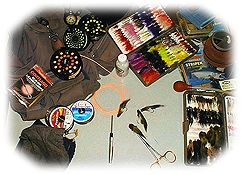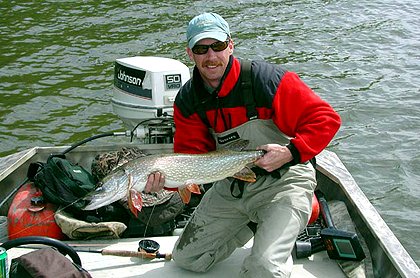

by Brad Hanson
| www.AlaskaFlyfishingOnline.com | ||
|
|

|

|
|
by Brad Hanson |
||
|
Alaskan Leech |
���Much of what trout eat is small stuff. Size 16 to 22 imitations do well to mimic aquatics that nourish the average trout, but on occasion, they feed on much larger food. Western anglers are familiar with the famed Salmon Fly hatch on the Madison, or the Green Drake on Henry's Fork. It's an event where every fish in the river feeds on monster bugs, and while the big fly, big fish scenario doesn't often play out, it's a memorable experience when it does.
The Naknek River in the Bristol Bay region is a renowned fishery, arguably boasting the world's largest rainbows. Small insects are not on the main-course as the oversized Bows feed nearly year-round on smolt, eggs, flesh, Sculpin, and Lamprey - all big-bite, high protein foods. It was while researching a trip that I realized, the spring fishery on the Naknek ranges off the big fly, big fish chart. I talked to guides and experienced anglers who consistently said, "huge black leeches - bigger the better." Granted, there were other flies mentioned, but they were suggested with this type of response, "oh, you might pick some up on this or that, but the big black leech...."
 Six-inch articulated leeches, no problem, but curiosity got the best of me and I had to know more about why big trout are slamming the unusually large flies. It seems logical that after a long winter they're just plain hungry. Or, in preparation for the rigors of spawning, there's a biological need to gain weight and build strength. Both true enough, but if it were only for hunger and a physical need, would they show a preference for one specific fly over another meaty imitation? It appears to be selective feeding.
I decided "they're after Lamprey." After all, they are common in Alaska's coastal waters, and they move to the freshwater shallows in the spring for their own spawning ritual. After spawning, they die promptly like salmon do. So, in certain waters, they're abundant and readily available. Regardless, I guess it's only important to know that big articulated leeches work for spring Bows on the Naknek and I suspect, they'll work for different big fish in other places too. Addendum: Since that memorable trip to the Naknek I've had the good fortune to experiment with this pattern and give it a try on Alaska's most voracious predator, the Northern Pike. Exactly as expected pike give this pattern about two seconds of consideration before slamming it with a vengeance. The pattern is extremely versatile and easily modified using component variations and different combinations of color. 
|